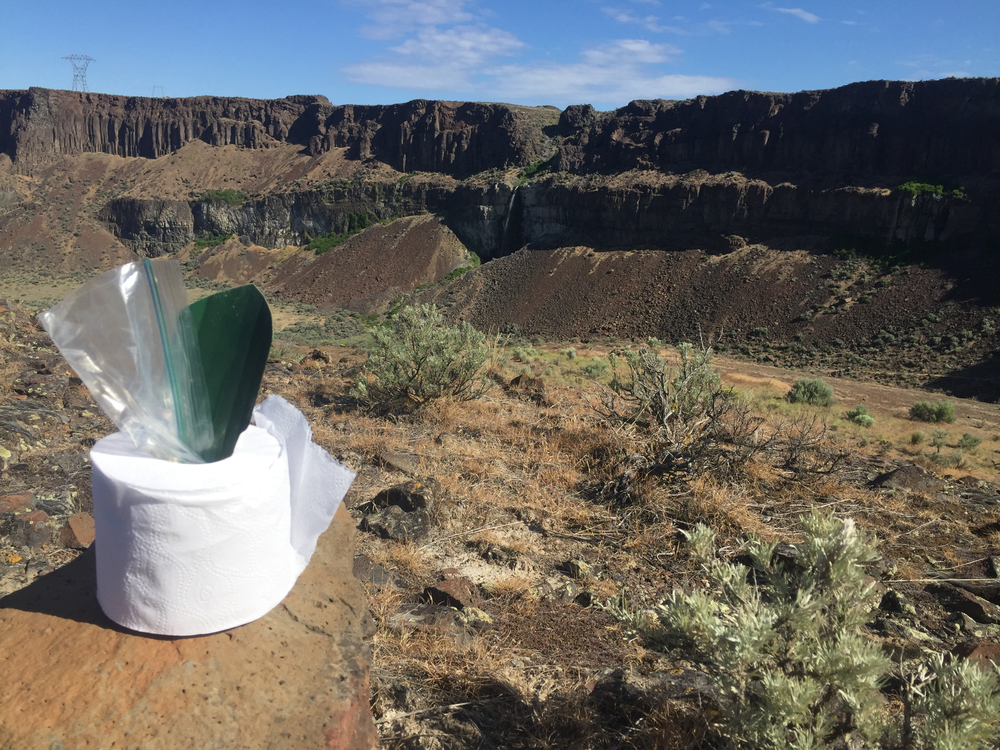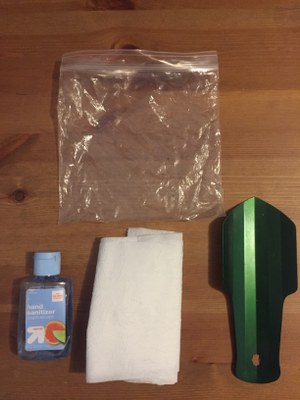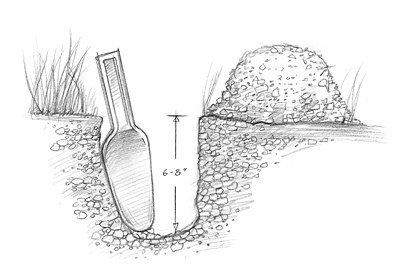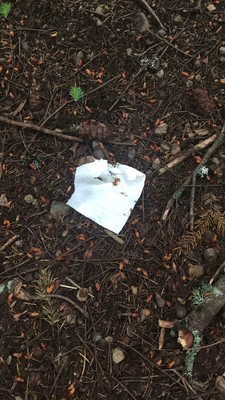
I am confident that you and I have at least two things in common: 1) we both set aside time to explore the outdoors, and 2) at some point during these adventures we will both experience the discomfort of knowing we have to go number two. Even if you don't, you will inevitably be reminded of this basic human function by the sight of toilet paper discarded uncomfortably close to trails and water sources. By the amount of TP I have seen recently on Washington’s trails, it seems even the most avid outdoor enthusiasts may not know how to handle nature’s calling.
No matter your outdoor experience, it's important to refresh your backcountry bathroom skills so your next rendezvous away from the comforts of indoor plumbing will be both sanitary and satisfying. I am here to assure you there's no need to fear digestive discomfort in the backcountry again!
Step One: Prepare
Before you leave for any type of trip, make sure you have everything you need to travel safely and responsibly. This means bringing the Ten Essentials and a few “eleventh” essentials for a bathroom break. The best option for waste disposal in the backcountry is to use an outhouse or privy (trailheads usually have them). When those are unavailable or too far away, catholes are the most widely accepted method to dispose of your human waste. Leaving it unburied on the topsoil is NOT an option. Whether you are hiking for a few hours or a few months, I recommend always carrying these items:
- Trowel
- Hand Sanitizer
- Toilet paper or gentle baby wipes
- A small bag
- An empty plastic bag (or two if you want to double bag)
Once upon a time, I was an anti-trowel gal. After the PCT, I now consider it to be a trusty friend. Sure, you can use a rock or branch to dig your cathole, but it's time consuming and more commonly, you cannot find one that will work. Save yourself the agony and buy a Deuce of Spades trowel. It only weighs 0.6 ounces, which is less than half a snickers bar. You’ll thank me later.

Store the trowel, hand sanitizer, and toilet paper in a bag that is easily accessible. If you are a minimalist, leave the TP at home and opt for natural items that are “dead and down” like leaves, branches, or flat stones. The natural materials need to be properly disposed of afterwards, which is discussed in more detail below. Long gone are the days you thought burying toilet paper was acceptable!
Some land managers require recreationists to pack out their poo using blue bags or wag bags, which can be purchased at outdoor retail stores or ranger stations. Check the area’s website for regulations before heading out. If your body does not give you much prep time, it would be wise to carry a blue bag even on day hikes.
Step Two: Give yourself ample time
This is important. In order to make your number two a four-star experience, you cannot be rushed. Be smart and give yourself plenty of time so you won't be forced into an embarrassing, unsanitary situation.
Step Three: Pick a spot
Okay, so it’s go time. Look for an area you can easily start walking 200 feet or 70 adult steps from any of the following:
- Trails
- Water sources
- Camps or frequented break spots
You will likely have to climb over trees or zigzag around obstacles during your 70 step adventure, which is why having ample time is key. I recommend counting your steps to keep track of how far you have gone. Also, take time to turn around so you will be able to find your way back to the trail or your camp spot. If you come across another water source, intersect the trail again, or pass a camp spot, you must go another 200 feet (70 steps) from there.
When you are at least 200 feet away (did I mention that is 70 adult steps?), you can start looking for an inconspicuous spot where other people will not walk or camp. Search for areas with soft ground and direct sunlight, which aids in decomposition. Avoid caves or areas under rock overhangs where decomposition is extremely slow, because they lack the necessary water percolation through the soil. A pretty view is a major bonus (#poopingwithaview).
Step Four: Dig a cathole
Use your trowel to dig a hole that is 6 to 8 inches deep and 4 to 6 inches in diameter. I recommend marking 4, 6, and 8 inches on your trowel before heading into the backcountry to help speed up the process. If you have to, you may need to dig a hole after your business is done. Follow the same guidelines (200 feet away from trails, water, camp spots) and use a stick to transfer all the waste materials. Don’t use your trowel for that.
Why do we need to dig?
Topsoil lacks enough organic material to break down human waste, meaning it will fester for far too long. Catholes help keep our waste from:
- Polluting water sources
- Spreading diseases
- All negative implications of it being encountered (I stepped in human poop while hiking in Grand Teton National Park a few years ago. VOMIT)
People are drawn to the outdoors for many reasons, but I am confident no one sets out hoping to encounter another person’s poop. Please, respect our public lands and take the time to dig a cathole.

I always aim to dig down 8 inches to be on the safe side and prevent animals from digging it up. Pile the dirt to the side so that you can use it to refill the hole afterwards. After digging, put the trowel back in your bag, so that you won’t forget it. Next, lay out the TP and open your “trash” plastic bag so you won’t have to fumble with anything during business time. Enjoy the view if you have one. If not, be thankful you are not stuck in a grimy public bathroom.
 REMEMBER: Burying your toilet paper (and/or wet wipes) is an archaic concept and is unacceptable. First off, your toilet paper is not designed to decompose in dirt. Even if it is biodegradable, an animal will likely dig it up (especially if your TP has a scent, which I am guessing it does). Your used toilet paper will then be free to do one of the three terrible things mentioned above (I saw this little gem to the left just off of the trail to Rattlesnake). Let’s all agree to live by the golden rule when it comes to TP. You don’t want to see other people’s toilet paper and you definitely don’t want to pick it up (or get sick from it). Be the change. Pack it out!
REMEMBER: Burying your toilet paper (and/or wet wipes) is an archaic concept and is unacceptable. First off, your toilet paper is not designed to decompose in dirt. Even if it is biodegradable, an animal will likely dig it up (especially if your TP has a scent, which I am guessing it does). Your used toilet paper will then be free to do one of the three terrible things mentioned above (I saw this little gem to the left just off of the trail to Rattlesnake). Let’s all agree to live by the golden rule when it comes to TP. You don’t want to see other people’s toilet paper and you definitely don’t want to pick it up (or get sick from it). Be the change. Pack it out!
Step Four: Pack it out
When you are done, make sure all of your used toilet paper / wet wipes are in the trash plastic bag. I recommend putting it into the bag as you go. Any used natural material should be left in the cathole. If you really want to aid in decomposition, you can stir the contents of the cathole. At minimum refill the hole with dirt and disguise it. The goal is to make it look like you were never there. When camping in the same place for multiple nights, widely disperse your catholes. Never go back to the same spot twice.
Throwing a rock or leaves on top of your deuce afterwards is not okay! The waste must be completely buried in dirt for it to decompose. Furthermore, volunteers who are spending their free time to optimize OUR hiking experience typically are the ones who find it. Studies have shown dangerous pathogens can survive up to a year in our buried waste. Take the time to keep our trails poop-free so our children, friends, pets, and generations for years to come can safely enjoy them too.
Step Five: Sanitize
For us outdoor enthusiasts, dirty can mean two things: covered in dirt (a sign of fun) or covered in germs (backcountry death wish). I recommend fully embracing the prior definition and doing everything you can to fight off the latter. Use hand sanitizer or wet wipes immediately after you are done dropping the D to minimize spreading germs. Better yet, bring some Dr. Bronner along to wash your hands. BONUS: be a good friend and have the soap and water ready when your friend gets back!
Questions? Other tips?
That wasn’t so uncomfortable, now was it? Drop me an email if you have any questions at sarahmccroy@gmail.com. You can find more information about disposing of your waste properly at Leave No Trace Center for Outdoor Ethics.
Add a comment
Log in to add comments.Great article. Thanks for the info. Appreciate the emphasis on digging a deep enough hole. So sick of people not doing that. And the trowel really helps, even if there are privies where you're camping, cause you might have to go before you get there.
Just a few quibbles.
1. You might consider advising folks to keep the trowel in a separate baggy to keep the tp/wipes more clean from dirt.
2. The guidelines for washing anything (hands, dishes, etc) are pretty much the same as those for pooping (200 feet from water, trails, camps, etc). As such, I think it's best to wash your hands right where you poop, not wait til you get back to camp. Consequently, it's a good idea to bring all the paraphernelia (soap, water bottle, towel) for handwashing when you poop.
Norm, thanks for bringing up those two points. I agree, keeping the trowel separate is a good idea. I usually keep mine in the same external pocket on my backpack as the baggie with my TP/hand sanitizer. You bring up a good point about washing your hands immediately after pooping instead of waiting until you get back to camp. Appreciate it!
A four-star experience! Very entertaining and informative article Sarah. If people balk at the price of the Deuce of Spades Trowel ($23 including shipping), an inexpensive alternative is the REI Snow Stake. It only costs $3 plus tax at your local store. It's 9.5 inches long, weighs 1 ounce, comes in shiny anodized orange finish, and it makes a great ultralight poop shovel, plus an extra emergency tent stake for your kit.
Thanks for the great suggestion, Russ. You are spot on with how you consider a piece of gear (light weight! fun bright color! multiple uses!) I know quite a few hikers who prefer the Snow Stake as a trowel too.
 Sarah McCroy
Sarah McCroy